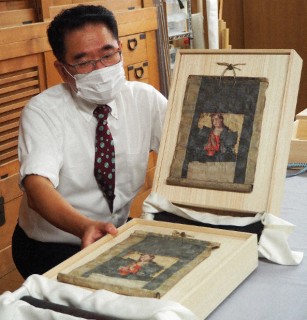Loading
Search
▼ Centuries-Old Painting Revered By Japan's Hidden Christians Restored; Pope To Get Replica
- Category:Other
KYOTO -- A painting of Mary, mother of Jesus, that was revered and preserved by hidden Christians in Japan during the Edo period (1603-1868) has been restored, and an intricate replica is set to be presented to Pope Francis when he visits Japan in November.
The painting, titled "Yuki no Santa Maria" (Our Lady of the Snows), was restored by Usami Shutokudo Corp., a company in Kyoto's Sakyo Ward that repairs books, works of art and other items using traditional techniques.
According to the Twenty-six Martyrs Museum in the western Japan city of Nagasaki, which houses the painting, there is a possibility that Pope Francis may view the painting when he visits a monument in front of the museum on Nov. 24. An intricate replica of the painting created by Usami Shutokudo will be presented to him.
"Yuki no Santa Maria" is believed to have been painted in the late 16th or early 17th century by a Japanese artist who learned Western-style painting from the Italian missionary Giovanni Cola (or Niccolo) of the Societatis Iesu (Society of Jesus). It is a small painting, measuring 11.3 centimeters in height and 11.5 centimeters in width. To hide it, it was attached to a scroll measuring 28.1 by 21.8 centimeters, and placed in a bamboo cylinder.
The replica was used in the 2016 film "Silence" directed by Martin Scorsese, which is based on the novel of the same name by Shusaku Endo, and Scorsese presented a photo of it to the pope when he saw him ahead of the release of the film.
After consultations with experts, it was decided that creases and dirt on the painting should be considered as part of the work as a whole. As it has become worn and damaged over time, the Kyoto company spent over half a year restoring it, attaching thin strips of high-quality paper to the back with the use of weak glue. At the same time, a close replica of the original was digitally printed, reproducing the texture, creases and other features of the original.
"It was a piece that hidden Christians risked their lives to create, so we carried out the work with attention to such thoughts. I'm relieved it's finished," said Naoharu Usami, CEO and founder of Usami Shutokudo. The restored painting was accepted by the museum on Nov. 17.
Michiko Fukaya, an associate professor at Kyoto City University of Arts who provided advice in the restoration of the painting, commented, "It's a rare item painted by a Japanese person before the temporary discontinuation of Japan's Western-style art, so it has high value from the perspective of art and religious history.
We were able to stabilize it in its current form, so there's a possibility that with the advancement of technology in the future, we may be able to bring it back close to the original condition when it was painted.
The painting, titled "Yuki no Santa Maria" (Our Lady of the Snows), was restored by Usami Shutokudo Corp., a company in Kyoto's Sakyo Ward that repairs books, works of art and other items using traditional techniques.
According to the Twenty-six Martyrs Museum in the western Japan city of Nagasaki, which houses the painting, there is a possibility that Pope Francis may view the painting when he visits a monument in front of the museum on Nov. 24. An intricate replica of the painting created by Usami Shutokudo will be presented to him.
"Yuki no Santa Maria" is believed to have been painted in the late 16th or early 17th century by a Japanese artist who learned Western-style painting from the Italian missionary Giovanni Cola (or Niccolo) of the Societatis Iesu (Society of Jesus). It is a small painting, measuring 11.3 centimeters in height and 11.5 centimeters in width. To hide it, it was attached to a scroll measuring 28.1 by 21.8 centimeters, and placed in a bamboo cylinder.
The replica was used in the 2016 film "Silence" directed by Martin Scorsese, which is based on the novel of the same name by Shusaku Endo, and Scorsese presented a photo of it to the pope when he saw him ahead of the release of the film.
After consultations with experts, it was decided that creases and dirt on the painting should be considered as part of the work as a whole. As it has become worn and damaged over time, the Kyoto company spent over half a year restoring it, attaching thin strips of high-quality paper to the back with the use of weak glue. At the same time, a close replica of the original was digitally printed, reproducing the texture, creases and other features of the original.
"It was a piece that hidden Christians risked their lives to create, so we carried out the work with attention to such thoughts. I'm relieved it's finished," said Naoharu Usami, CEO and founder of Usami Shutokudo. The restored painting was accepted by the museum on Nov. 17.
Michiko Fukaya, an associate professor at Kyoto City University of Arts who provided advice in the restoration of the painting, commented, "It's a rare item painted by a Japanese person before the temporary discontinuation of Japan's Western-style art, so it has high value from the perspective of art and religious history.
We were able to stabilize it in its current form, so there's a possibility that with the advancement of technology in the future, we may be able to bring it back close to the original condition when it was painted.
- November 22, 2019
- Comment (0)
- Trackback(0)


